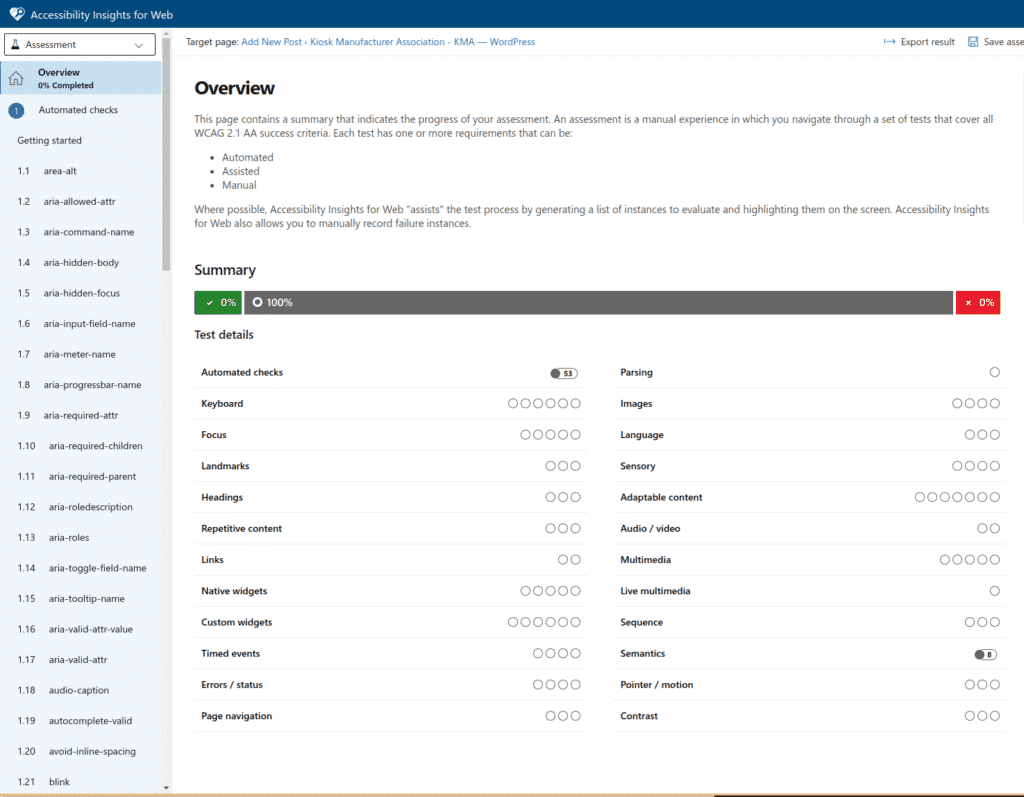
An Introduction to Website Accessibility
We sat in on the Thursday, May 5, 2022 Session. Bruce Bailey of U.S. Access Board led the discussion and as usual provided the “kitchen sink” when it comes to website accessibility. Below are the materials from that session.
We have also included our personal tips for testing and providing website accessibility. We recommend getting on the mailing list for U.S. Access Board and continuing your education and learning regarding accessibility.
Description
Everyone needs access to digital information provided by the World Wide Web. However, many websites have subtle barriers that prevent people with disabilities from using content. Fortunately, accessibility is not difficult to implement, and most accessibility features do not require significant changes to the visual presentation. This session will review what web accessibility is, how people with disabilities use the web, how to quickly identify accessibility barriers, and what are some simple solutions. Access Board IT Specialist Bruce Bailey will also clarify common sources of confusion about web accessibility and provide key resources for learning more about website accessibility. Questions can be submitted in advance of the session or can be posed during the live webinar. This webinar will include video remote interpreting (VRI) and real-time captioning. Webinar attendees can earn continuing education credits.
Multimedia Archives
Playback Video
Note: No credit is available for reviewing the recorded session.
 PowerPoint-Website Accessibility 5-5-2022 (Power Point File)
PowerPoint-Website Accessibility 5-5-2022 (Power Point File)
 Handout Web Accessibility 5-5-2022 2slides perpage (PDF File)
Handout Web Accessibility 5-5-2022 2slides perpage (PDF File)
 Handout Web Accessibility 5-5-2022 RTF (RTF File)
Handout Web Accessibility 5-5-2022 RTF (RTF File)
Speakers
Bruce Bailey IT Specialist, U.S. Access Board
Useful Tips for Testing, Implementing and Providing Website Accessibility
- “Magic bullet” plugins for WordPress and other CMS web systems — Generally these are “accessibility theater”. We have tested and tried many of these. It’s important to note that when we say “tested” we mean we have had disabled users of different tenors actually try the website and let us know what passed and what failed.
- Generally tab stops, alt text for images, a readable base font of 16 (1 em is rule) and sufficient contrast ratios for text and hyperlinks is a good place to start’
- Videos are becoming more commonplace. Accurate and understandable captions are required. Transcripts are nice for dialogue but they do not mitigate lack of captions in the actual video. There are a variety of transcription services.
- Running WordPress ourselves, we have considered activating plugin such as WAH Accessibility Pro. It provides some nice control of text, zoom and even audio. As a plugin it has a relatively light footprint when it comes to load factor. A WP site with Google dev speed of 99 (e.g. kma.global) will drop to around 85 with the plugin fully configured. You can mitigate load factor by utilizing CDN like Cloudflare (highly recommended). That should bring it back to around 95.
- Checking your site
- WCAG 2.1 Level AA is base reference
- We like the new insights from Microsoft Edge browser — it has a fast check that catches stupid mistakes and then more in depth test
- A great reference site and another testing tool is webaim
- Don’t pay for a testing tool
Legal Actions regarding ADA
We maintain a chronology of regulatory “events” (aka lawyers in action) at kioskindustry Legal News. We often use the acronym “FOBS” which rhymes with sobs and stands for Fear of Being Sued. Going cheap not only costs more money, but it narrows your audience. The disabled community is 25 million or so and it is only increasing. Think of them as customers. Japan does.. For reference, Japan is aging rapidly, those over 65 already constituted 27.7% of the total population in 2017. This figure is the highest in the world and is projected to grow continuously up to 38.4% in 2065. These are trends that we will likely see in the U.S. and Europe for that matter.

